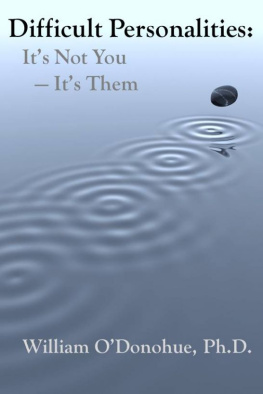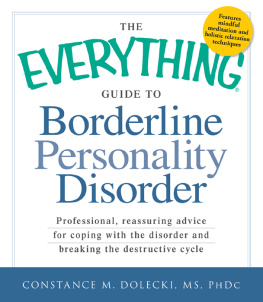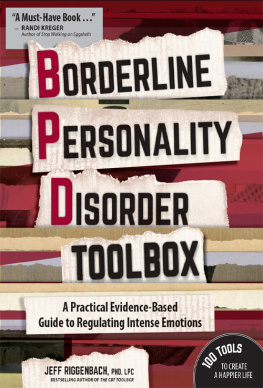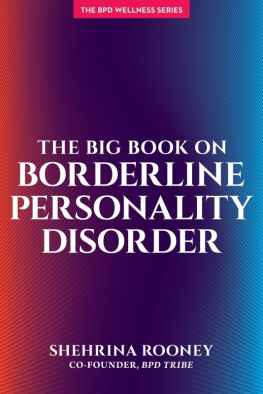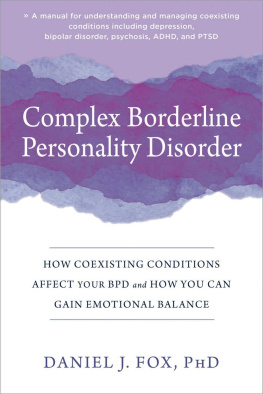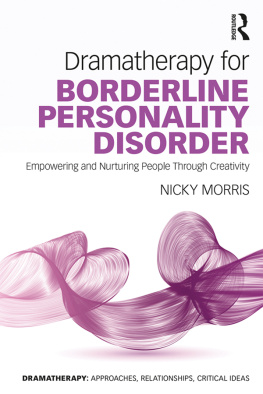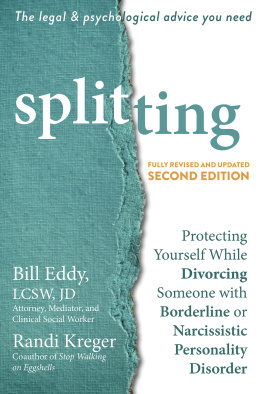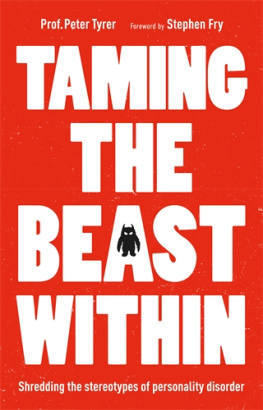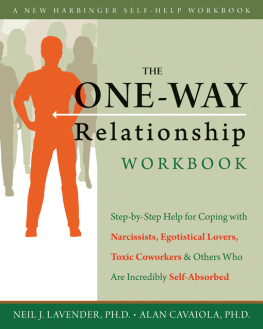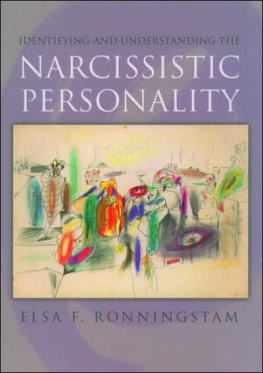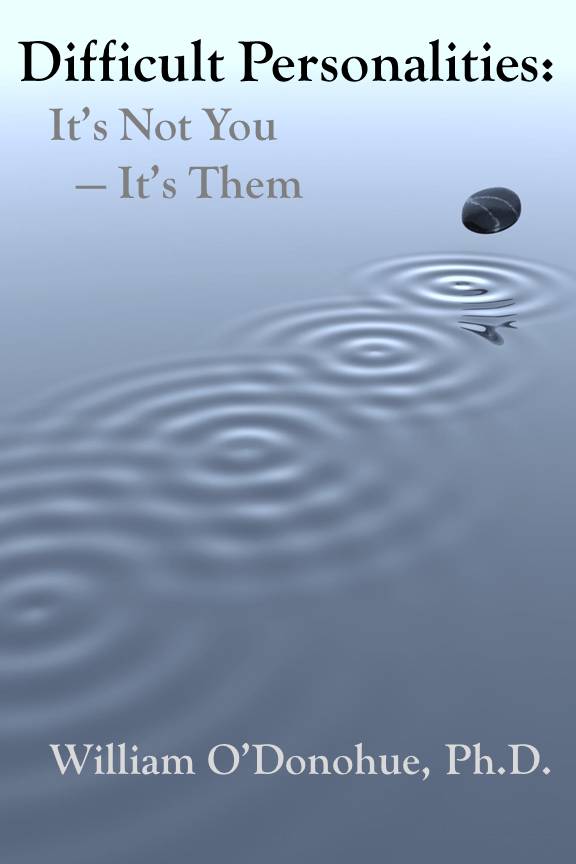
Difficult Personalities: Its Not You, ItsThem
By William ODonohue, PhD
Some people are very, very tough to deal with and canmake you miserable. This is a sad fact of life. This book will helpyou identify, understand and develop strategies to deal with toxicpersonalities you encounter. Written by a prominent clinicalpsychologist and university professor it explains DSM diagnosticcategories such as Anti-social Personality Disorder, BorderlinePersonality Disorder, Narcissistic Personality Disorder and othersso that you can make a better determination of whether you aredealing with one of these kinds of individuals, what science andclinical experience says about these, and most importantly how todeal more effectively with these. This information can help youmove from being poisoned by these individuals to regaining controlof your life.
A Lucky Bat Book

Difficult Personalities: Its Not You, Its Them
Copyright 2011 by William ODonohue
All rights reserved
Cover Artist:
Stefan Thamm | 3D-Illustration,
http://www.stefanthamm.de
Published by Lucky Bat Books
http://www.LuckyBatBooks.com
Smashwords License Notes
This e-book is licensed for your personal enjoymentonly. This e-book may not be resold or given away to other people.If you would like to share this book with other people, pleasepurchase additional copies. If youre reading this book and did notpurchase it, or it was not purchased for your use only, then pleasereturn it to Smashwords for your own copy. Thank you for respectingthe hard work of this author.
Acknowledgements
I would like to acknowledge the expert assistance ofDr. Kendra Beitz-Thompson, PhD, and Dr. Elizabeth Mosco, PhD, fortheir assistance on this manuscript. The author would also like tothank Cindie Geddes for all her expertise in producing thise-book.
About the Author
William ODonohue, PhD, is a licensed psychologistand a Professor of Clinical Psychology at the University of Nevada,Reno. He has published more than 60 books and 150 journal articlesand book chapters. He can be reached .
Foreword
I wrote this book because I wanted to help peopleunderstand toxic personalities in their lives. These individualscause a lot of pain. They generally dont get betterdespiterepeated promises and attemptsand thus cause a lot of problems fora very long time.
I have had a significant amount of professional andpersonal experience with these individuals. I co-edited a scholarlybook that comprehensively covered each of the DSM-IVTRPersonality Disorders: Personality Disorders: Toward theDSM-V (Sage, 2007). I have also assessed and treated a largenumber of these individuals in my 25-year clinical practice. Andfinally, unfortunately, I have come across these individuals in mypersonal life.
Nothing in this book is meant to demonize thesedifficult and toxic individuals. This book is meant to help youidentify themignorance is not bliss when it comes to theseindividuals. This book also then gives some basic facts about theseindividualsI want you to understand what you are up against.Finally, it gives some practical strategies for dealing with theseindividuals in your life. I hope you find this information helpfuland would like to hear any reactions that you might want to share.I can be reached at .
This book is not meant to replace professionaldiagnoses or services. If you are wondering about whether a lovedone actually merits a personality disorder diagnosis, you mustencourage them to see a competent professional. And if your lifehas been so affected by one of these individuals that you feeloverwhelmed, stressed, down, or some other serious negativeemotion, I would also encourage you also to seek professionalhelp.
Finally, you do not have to read this book from coverto cover. You can go directly to the chapter that may interest you.The first chapter does provide some nice general backgroundinformation that may be useful. But if you think that you mighthave a particular type of individual in your life, by all means goto that chapter. However, one of the points this book makes is thatoften there is comorbiditythere is overlap in symptoms acrossspecific diagnoses within the three general clusters of personalitydisorders. Therefore, it might be most useful to read all thechapters in a particular cluster.
Disclaimer
The ideas, suggestions, and procedures in the bookare not intended to be a substitute for consulting with a mentalhealth professional or your physician. All matters regarding yourhealth require medical or mental health supervision.
Table of Contents
Acknowledgements
Chapter 1: DifficultPersonalities
Understanding yourself and understanding other peopleare probably two of lifes biggest challenges. Understanding whoyou are, learning to take care of yourself, recognizing yourweaknesses, and dealing with these successfully are hard enoughtasks. Understanding and successfully dealing with others is evenmore difficult. Clearly, interacting with others is never entirelyproblem-free (the French existential philosopher Sartre famouslysaid, People are hell), but there are certain kinds of people whogive us more than their share of difficulty. They have what we willcall difficult personalities. In fact, when we add up allthe numbers of all the difficult personalities, 1 in 7 peoplequalify as a difficult personality. This is not according to me; itis according to the estimates provided by the American PsychiatricAssociation. In addition, countless more people have so manycharacteristics of these difficult or toxic personalities that theyare close enough to count as difficult. This book is written tohelp you recognize, understand, and decide how to deal with thesedifficult personalities.
First, you need to know how to identify these people.You probably have some ideaa good and very important sign is thatyou see them causing you and/or others a lot of hassle. However,ignoranceeven partial ignorancein these cases, is not bliss.Ignorance can set you up for more pain and trouble. You also needto sufficiently understand these people so you can developeffective strategies for minimizing their negative impact on yourlife. This book will try to help you with these challenges.
I wrote this book to share important information thatis well known by mental health professionals but not widely knownby folks outside psychiatry, psychology, counseling, and socialwork. We believe that many people suffer needlesslyfeel hurt,confused, or frustrated because they dont know or understand thisinformation. I want to get this information out so the needlesspain experienced by you and others you care about can be minimized.This is especially important because these difficult personalitiescan play key roles in our lives. They might be our spouses, bosses,parents, neighbors, employees, or someone in almost any role.
I have missed identifying a few of these individualsin my own life and I have needlessly suffered, too. For example, Ionce had a boss who was an individual with one type of difficultpersonality known as Narcissistic Personality Disorder (see Chapter4). It was early in my career and despite being a clinicalpsychologist, I (foolishly) didnt recognize that this person had adifficult personality. I was trained in both psychology andphilosophy and learned to articulate weaknesses in peoplesarguments and conclusions, and I believe I am pretty good at this.One time my boss decided that the departments merit committee gaveme too high of a yearly merit rating. My boss thought the meritcommittee missed something, and thus lowered the rating, whichdecreased the raise I was to receive in the subsequent year. Myboss, in retrospect, was envious that I was doing betterfinancially then he was (Narcissistic Personalities constantly needto see themselves in the top position, and thus want to suppressany further gains by others. They are envious of others success.).In a meeting with my boss and some other superiors I pointed outsome holes in my bosss argument of why my merit should be lowered.According to the others present I was doing a fairly good jobadebate coach would have clearly given me the lead. But suddenly myboss stood up and shouted, Im going to kill you. He was so angryand disturbed his face was red, he was shaking his fists, and tearswere streaming down his face. What I didnt realize is that winningarguments with a Narcissist causes a narcissistic insult. It doesnot cause this kind of person to change his or her mind or tocompromise. It is, in fact, one of the worst things to do in thissituation. When Narcissistic Personalities feel insulted andattacked, they can respond very emotionally and very strongly. Irealized then that I needed better ways of identifying thesedifficult personalities and dealing with them. This book is theresult of years thinking, reading, and exploring this problem.
Next page
